Human Resource Development Report: BBC Training and Development
VerifiedAdded on 2020/06/04
|18
|5114
|128
Report
AI Summary
This report provides a detailed analysis of Human Resource Development (HRD) practices within the British Broadcasting Corporation (BBC). It begins by comparing different learning styles, including Kolb's theory, Honey and Mumford's approach, and VARK modalities, highlighting their application in the workplace. The report then examines the learning curve and the importance of knowledge transfer, particularly through induction programs. The evaluation of learning styles is discussed, focusing on planning and decision-making in training events. The report further compares training needs at various organizational levels within BBC and evaluates the advantages and disadvantages of different training methods, such as seminars, e-learning, and classroom sessions. A systematic approach to planning training and development is outlined. The report also covers evaluation techniques for staff training, including the evaluation of training events and a review of the success of evaluation methods. Finally, the report explores the role of government in training, development, and lifelong learning, the impact of the competency movement, and specific training initiatives introduced by the UK government. The conclusion summarizes the key findings and recommendations for effective HRD within BBC.
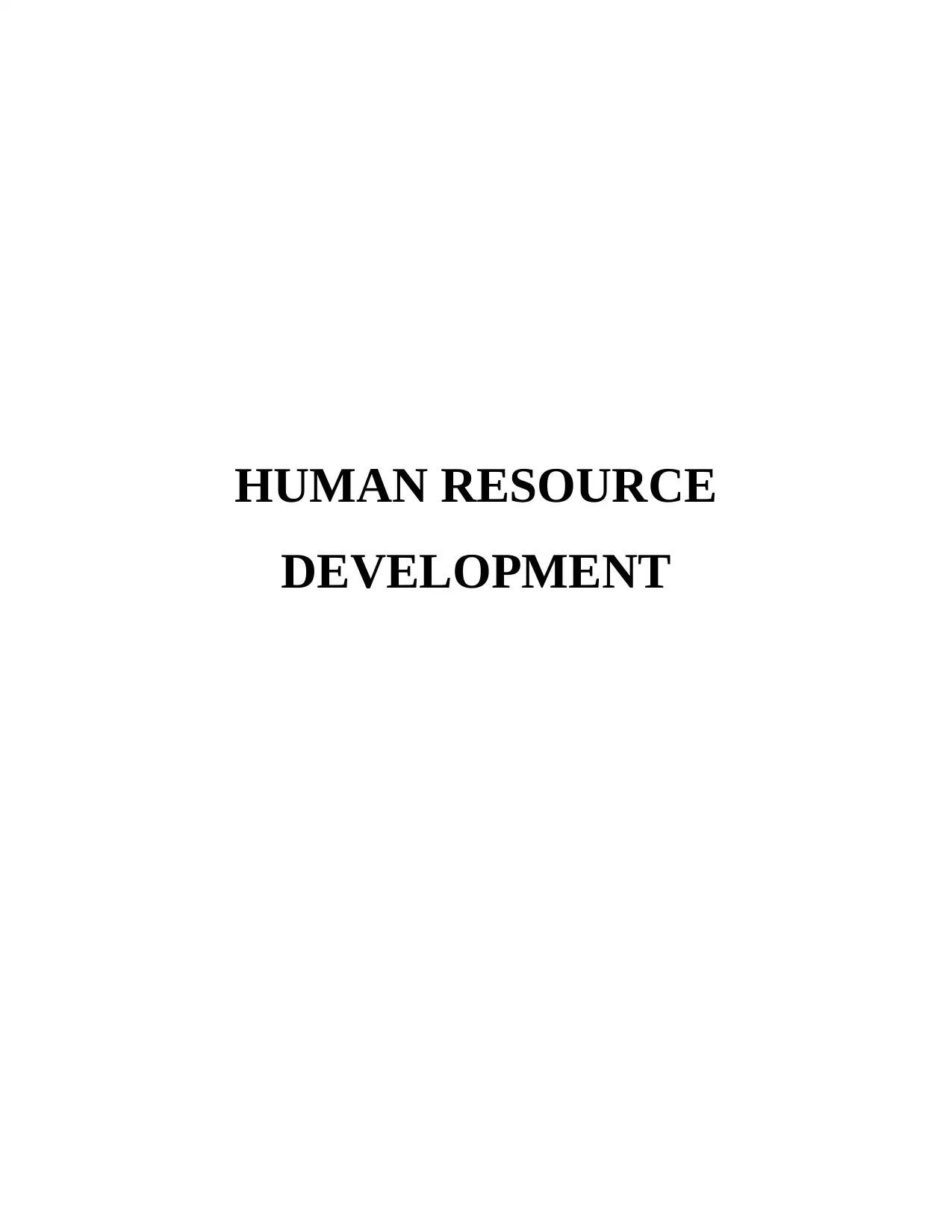
HUMAN RESOURCE
DEVELOPMENT
DEVELOPMENT
Paraphrase This Document
Need a fresh take? Get an instant paraphrase of this document with our AI Paraphraser
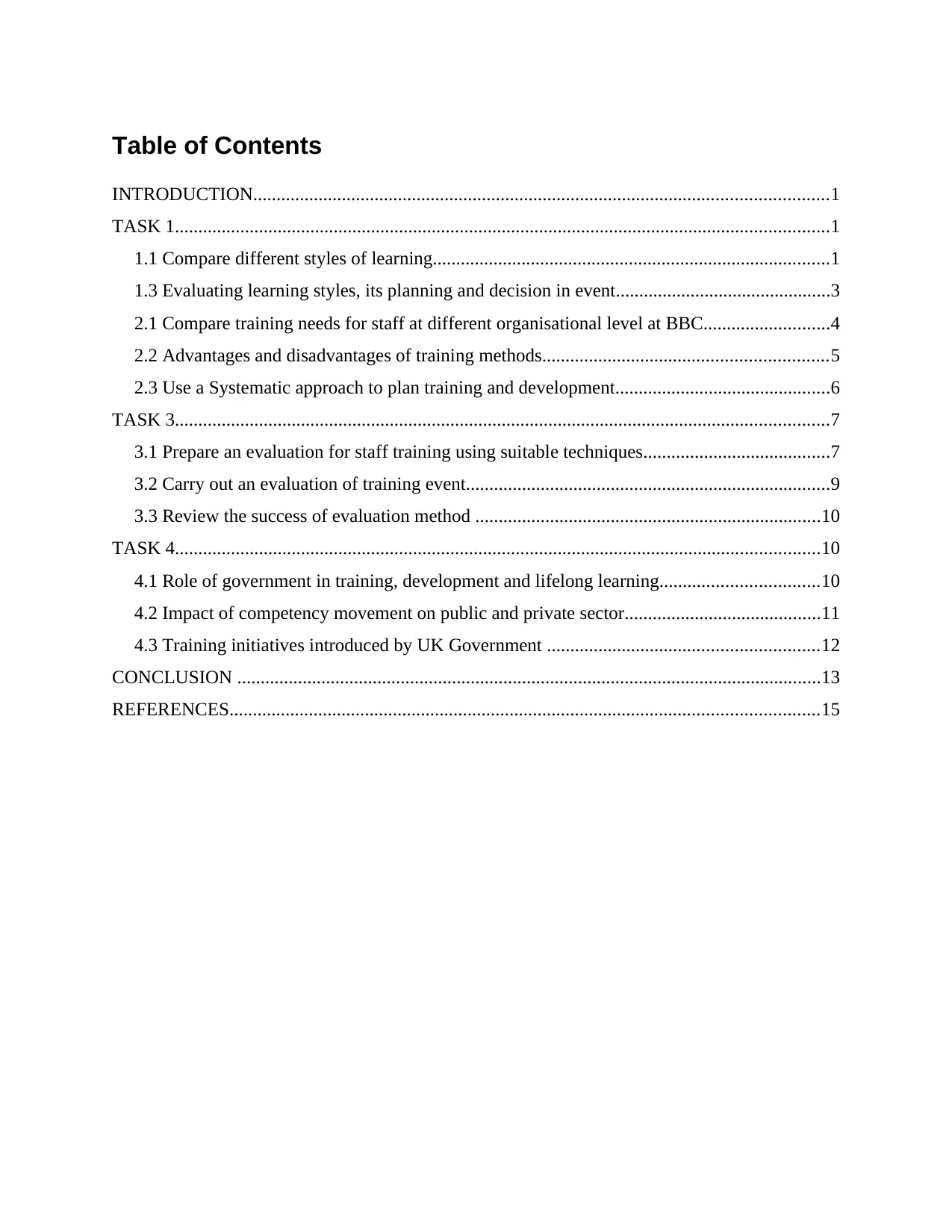
Table of Contents
INTRODUCTION...........................................................................................................................1
TASK 1............................................................................................................................................1
1.1 Compare different styles of learning.....................................................................................1
1.3 Evaluating learning styles, its planning and decision in event..............................................3
2.1 Compare training needs for staff at different organisational level at BBC...........................4
2.2 Advantages and disadvantages of training methods.............................................................5
2.3 Use a Systematic approach to plan training and development..............................................6
TASK 3............................................................................................................................................7
3.1 Prepare an evaluation for staff training using suitable techniques........................................7
3.2 Carry out an evaluation of training event..............................................................................9
3.3 Review the success of evaluation method ..........................................................................10
TASK 4..........................................................................................................................................10
4.1 Role of government in training, development and lifelong learning..................................10
4.2 Impact of competency movement on public and private sector..........................................11
4.3 Training initiatives introduced by UK Government ..........................................................12
CONCLUSION .............................................................................................................................13
REFERENCES..............................................................................................................................15
INTRODUCTION...........................................................................................................................1
TASK 1............................................................................................................................................1
1.1 Compare different styles of learning.....................................................................................1
1.3 Evaluating learning styles, its planning and decision in event..............................................3
2.1 Compare training needs for staff at different organisational level at BBC...........................4
2.2 Advantages and disadvantages of training methods.............................................................5
2.3 Use a Systematic approach to plan training and development..............................................6
TASK 3............................................................................................................................................7
3.1 Prepare an evaluation for staff training using suitable techniques........................................7
3.2 Carry out an evaluation of training event..............................................................................9
3.3 Review the success of evaluation method ..........................................................................10
TASK 4..........................................................................................................................................10
4.1 Role of government in training, development and lifelong learning..................................10
4.2 Impact of competency movement on public and private sector..........................................11
4.3 Training initiatives introduced by UK Government ..........................................................12
CONCLUSION .............................................................................................................................13
REFERENCES..............................................................................................................................15
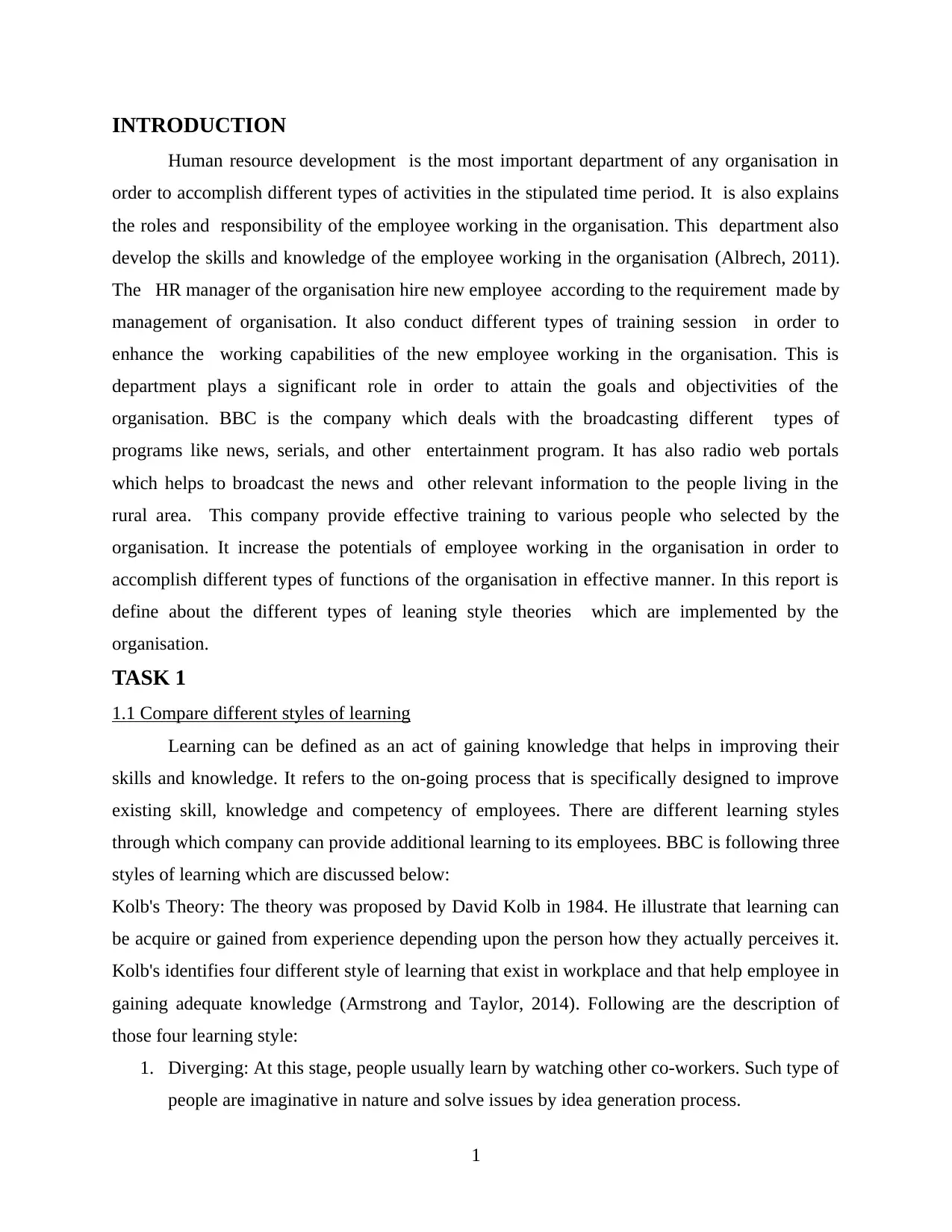
INTRODUCTION
Human resource development is the most important department of any organisation in
order to accomplish different types of activities in the stipulated time period. It is also explains
the roles and responsibility of the employee working in the organisation. This department also
develop the skills and knowledge of the employee working in the organisation (Albrech, 2011).
The HR manager of the organisation hire new employee according to the requirement made by
management of organisation. It also conduct different types of training session in order to
enhance the working capabilities of the new employee working in the organisation. This is
department plays a significant role in order to attain the goals and objectivities of the
organisation. BBC is the company which deals with the broadcasting different types of
programs like news, serials, and other entertainment program. It has also radio web portals
which helps to broadcast the news and other relevant information to the people living in the
rural area. This company provide effective training to various people who selected by the
organisation. It increase the potentials of employee working in the organisation in order to
accomplish different types of functions of the organisation in effective manner. In this report is
define about the different types of leaning style theories which are implemented by the
organisation.
TASK 1
1.1 Compare different styles of learning
Learning can be defined as an act of gaining knowledge that helps in improving their
skills and knowledge. It refers to the on-going process that is specifically designed to improve
existing skill, knowledge and competency of employees. There are different learning styles
through which company can provide additional learning to its employees. BBC is following three
styles of learning which are discussed below:
Kolb's Theory: The theory was proposed by David Kolb in 1984. He illustrate that learning can
be acquire or gained from experience depending upon the person how they actually perceives it.
Kolb's identifies four different style of learning that exist in workplace and that help employee in
gaining adequate knowledge (Armstrong and Taylor, 2014). Following are the description of
those four learning style:
1. Diverging: At this stage, people usually learn by watching other co-workers. Such type of
people are imaginative in nature and solve issues by idea generation process.
1
Human resource development is the most important department of any organisation in
order to accomplish different types of activities in the stipulated time period. It is also explains
the roles and responsibility of the employee working in the organisation. This department also
develop the skills and knowledge of the employee working in the organisation (Albrech, 2011).
The HR manager of the organisation hire new employee according to the requirement made by
management of organisation. It also conduct different types of training session in order to
enhance the working capabilities of the new employee working in the organisation. This is
department plays a significant role in order to attain the goals and objectivities of the
organisation. BBC is the company which deals with the broadcasting different types of
programs like news, serials, and other entertainment program. It has also radio web portals
which helps to broadcast the news and other relevant information to the people living in the
rural area. This company provide effective training to various people who selected by the
organisation. It increase the potentials of employee working in the organisation in order to
accomplish different types of functions of the organisation in effective manner. In this report is
define about the different types of leaning style theories which are implemented by the
organisation.
TASK 1
1.1 Compare different styles of learning
Learning can be defined as an act of gaining knowledge that helps in improving their
skills and knowledge. It refers to the on-going process that is specifically designed to improve
existing skill, knowledge and competency of employees. There are different learning styles
through which company can provide additional learning to its employees. BBC is following three
styles of learning which are discussed below:
Kolb's Theory: The theory was proposed by David Kolb in 1984. He illustrate that learning can
be acquire or gained from experience depending upon the person how they actually perceives it.
Kolb's identifies four different style of learning that exist in workplace and that help employee in
gaining adequate knowledge (Armstrong and Taylor, 2014). Following are the description of
those four learning style:
1. Diverging: At this stage, people usually learn by watching other co-workers. Such type of
people are imaginative in nature and solve issues by idea generation process.
1
⊘ This is a preview!⊘
Do you want full access?
Subscribe today to unlock all pages.

Trusted by 1+ million students worldwide
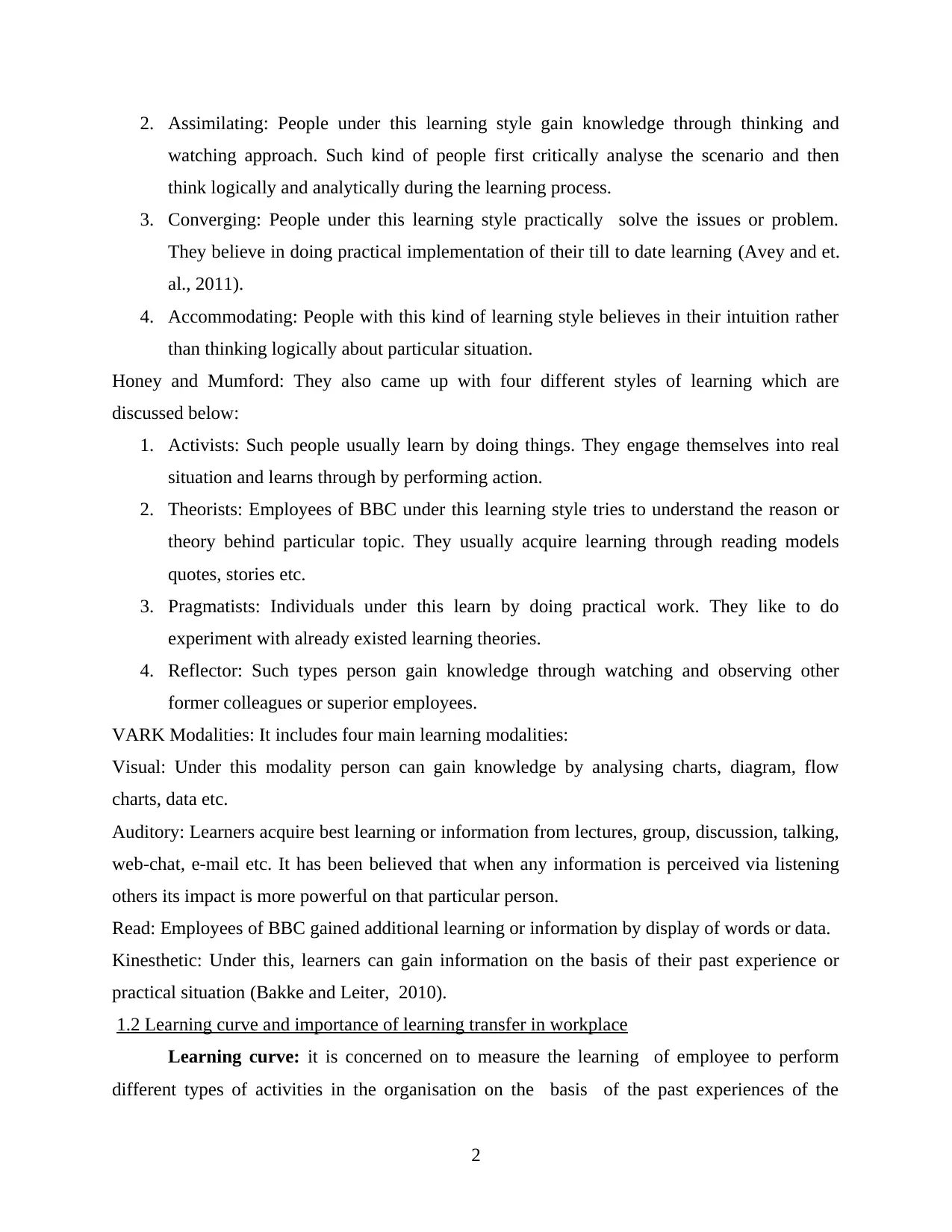
2. Assimilating: People under this learning style gain knowledge through thinking and
watching approach. Such kind of people first critically analyse the scenario and then
think logically and analytically during the learning process.
3. Converging: People under this learning style practically solve the issues or problem.
They believe in doing practical implementation of their till to date learning (Avey and et.
al., 2011).
4. Accommodating: People with this kind of learning style believes in their intuition rather
than thinking logically about particular situation.
Honey and Mumford: They also came up with four different styles of learning which are
discussed below:
1. Activists: Such people usually learn by doing things. They engage themselves into real
situation and learns through by performing action.
2. Theorists: Employees of BBC under this learning style tries to understand the reason or
theory behind particular topic. They usually acquire learning through reading models
quotes, stories etc.
3. Pragmatists: Individuals under this learn by doing practical work. They like to do
experiment with already existed learning theories.
4. Reflector: Such types person gain knowledge through watching and observing other
former colleagues or superior employees.
VARK Modalities: It includes four main learning modalities:
Visual: Under this modality person can gain knowledge by analysing charts, diagram, flow
charts, data etc.
Auditory: Learners acquire best learning or information from lectures, group, discussion, talking,
web-chat, e-mail etc. It has been believed that when any information is perceived via listening
others its impact is more powerful on that particular person.
Read: Employees of BBC gained additional learning or information by display of words or data.
Kinesthetic: Under this, learners can gain information on the basis of their past experience or
practical situation (Bakke and Leiter, 2010).
1.2 Learning curve and importance of learning transfer in workplace
Learning curve: it is concerned on to measure the learning of employee to perform
different types of activities in the organisation on the basis of the past experiences of the
2
watching approach. Such kind of people first critically analyse the scenario and then
think logically and analytically during the learning process.
3. Converging: People under this learning style practically solve the issues or problem.
They believe in doing practical implementation of their till to date learning (Avey and et.
al., 2011).
4. Accommodating: People with this kind of learning style believes in their intuition rather
than thinking logically about particular situation.
Honey and Mumford: They also came up with four different styles of learning which are
discussed below:
1. Activists: Such people usually learn by doing things. They engage themselves into real
situation and learns through by performing action.
2. Theorists: Employees of BBC under this learning style tries to understand the reason or
theory behind particular topic. They usually acquire learning through reading models
quotes, stories etc.
3. Pragmatists: Individuals under this learn by doing practical work. They like to do
experiment with already existed learning theories.
4. Reflector: Such types person gain knowledge through watching and observing other
former colleagues or superior employees.
VARK Modalities: It includes four main learning modalities:
Visual: Under this modality person can gain knowledge by analysing charts, diagram, flow
charts, data etc.
Auditory: Learners acquire best learning or information from lectures, group, discussion, talking,
web-chat, e-mail etc. It has been believed that when any information is perceived via listening
others its impact is more powerful on that particular person.
Read: Employees of BBC gained additional learning or information by display of words or data.
Kinesthetic: Under this, learners can gain information on the basis of their past experience or
practical situation (Bakke and Leiter, 2010).
1.2 Learning curve and importance of learning transfer in workplace
Learning curve: it is concerned on to measure the learning of employee to perform
different types of activities in the organisation on the basis of the past experiences of the
2
Paraphrase This Document
Need a fresh take? Get an instant paraphrase of this document with our AI Paraphraser
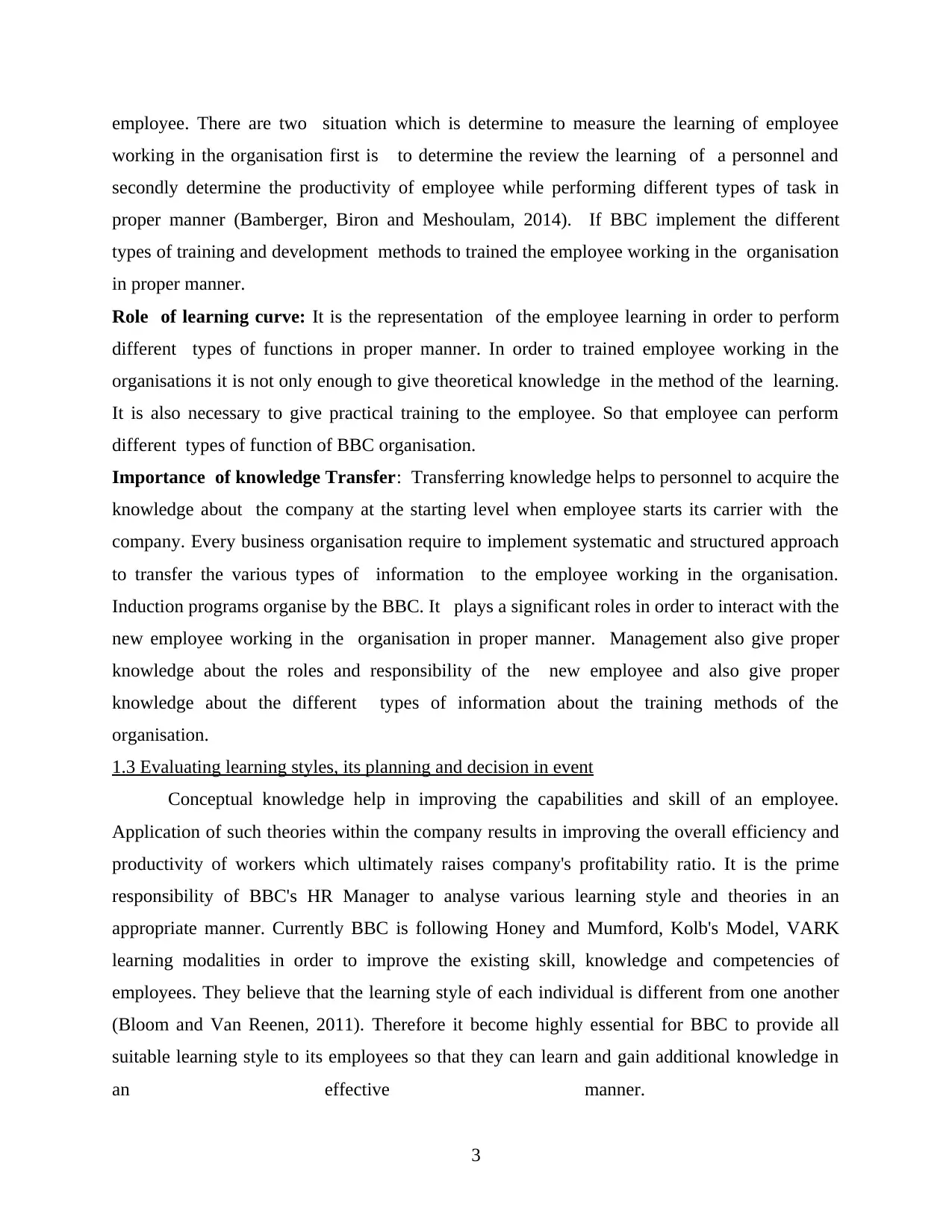
employee. There are two situation which is determine to measure the learning of employee
working in the organisation first is to determine the review the learning of a personnel and
secondly determine the productivity of employee while performing different types of task in
proper manner (Bamberger, Biron and Meshoulam, 2014). If BBC implement the different
types of training and development methods to trained the employee working in the organisation
in proper manner.
Role of learning curve: It is the representation of the employee learning in order to perform
different types of functions in proper manner. In order to trained employee working in the
organisations it is not only enough to give theoretical knowledge in the method of the learning.
It is also necessary to give practical training to the employee. So that employee can perform
different types of function of BBC organisation.
Importance of knowledge Transfer: Transferring knowledge helps to personnel to acquire the
knowledge about the company at the starting level when employee starts its carrier with the
company. Every business organisation require to implement systematic and structured approach
to transfer the various types of information to the employee working in the organisation.
Induction programs organise by the BBC. It plays a significant roles in order to interact with the
new employee working in the organisation in proper manner. Management also give proper
knowledge about the roles and responsibility of the new employee and also give proper
knowledge about the different types of information about the training methods of the
organisation.
1.3 Evaluating learning styles, its planning and decision in event
Conceptual knowledge help in improving the capabilities and skill of an employee.
Application of such theories within the company results in improving the overall efficiency and
productivity of workers which ultimately raises company's profitability ratio. It is the prime
responsibility of BBC's HR Manager to analyse various learning style and theories in an
appropriate manner. Currently BBC is following Honey and Mumford, Kolb's Model, VARK
learning modalities in order to improve the existing skill, knowledge and competencies of
employees. They believe that the learning style of each individual is different from one another
(Bloom and Van Reenen, 2011). Therefore it become highly essential for BBC to provide all
suitable learning style to its employees so that they can learn and gain additional knowledge in
an effective manner.
3
working in the organisation first is to determine the review the learning of a personnel and
secondly determine the productivity of employee while performing different types of task in
proper manner (Bamberger, Biron and Meshoulam, 2014). If BBC implement the different
types of training and development methods to trained the employee working in the organisation
in proper manner.
Role of learning curve: It is the representation of the employee learning in order to perform
different types of functions in proper manner. In order to trained employee working in the
organisations it is not only enough to give theoretical knowledge in the method of the learning.
It is also necessary to give practical training to the employee. So that employee can perform
different types of function of BBC organisation.
Importance of knowledge Transfer: Transferring knowledge helps to personnel to acquire the
knowledge about the company at the starting level when employee starts its carrier with the
company. Every business organisation require to implement systematic and structured approach
to transfer the various types of information to the employee working in the organisation.
Induction programs organise by the BBC. It plays a significant roles in order to interact with the
new employee working in the organisation in proper manner. Management also give proper
knowledge about the roles and responsibility of the new employee and also give proper
knowledge about the different types of information about the training methods of the
organisation.
1.3 Evaluating learning styles, its planning and decision in event
Conceptual knowledge help in improving the capabilities and skill of an employee.
Application of such theories within the company results in improving the overall efficiency and
productivity of workers which ultimately raises company's profitability ratio. It is the prime
responsibility of BBC's HR Manager to analyse various learning style and theories in an
appropriate manner. Currently BBC is following Honey and Mumford, Kolb's Model, VARK
learning modalities in order to improve the existing skill, knowledge and competencies of
employees. They believe that the learning style of each individual is different from one another
(Bloom and Van Reenen, 2011). Therefore it become highly essential for BBC to provide all
suitable learning style to its employees so that they can learn and gain additional knowledge in
an effective manner.
3
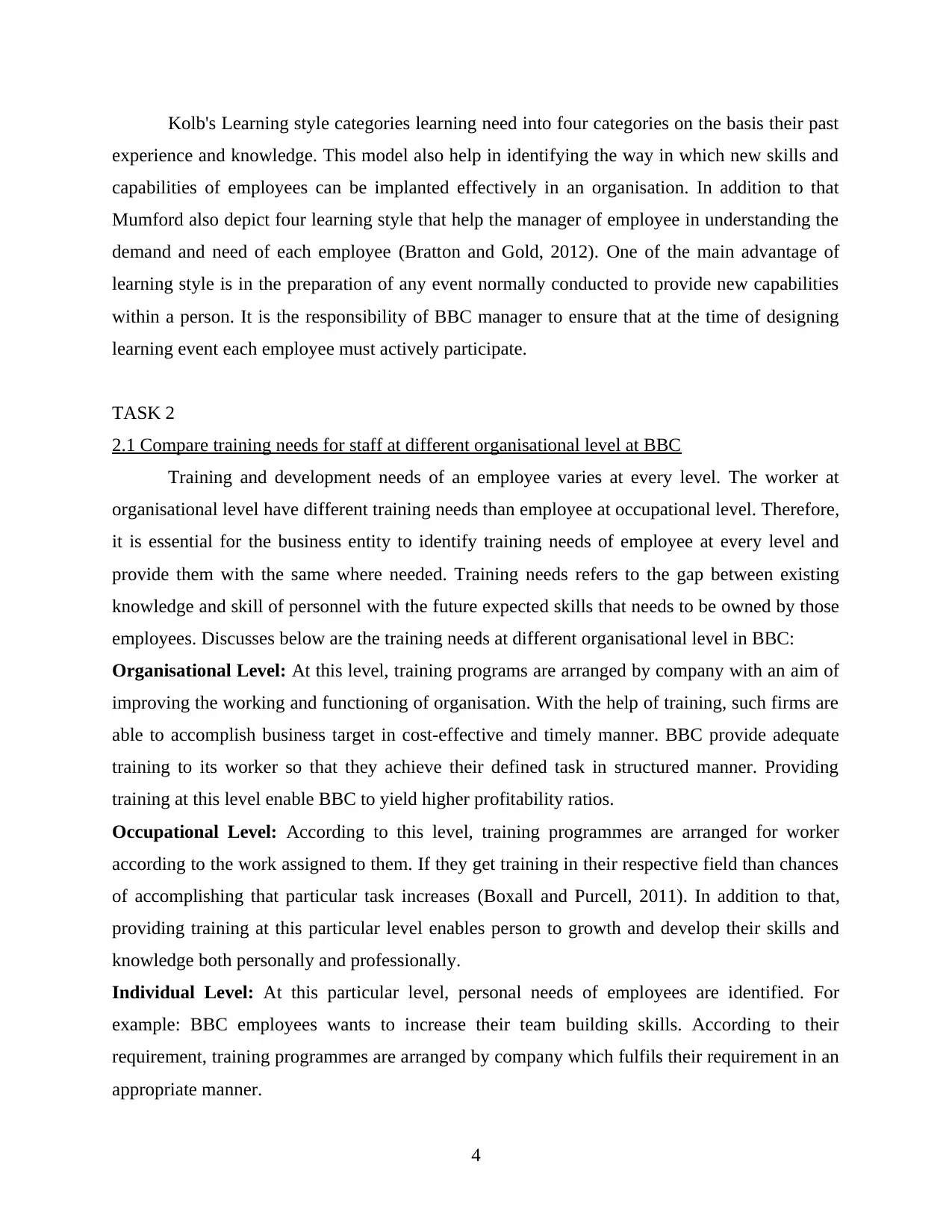
Kolb's Learning style categories learning need into four categories on the basis their past
experience and knowledge. This model also help in identifying the way in which new skills and
capabilities of employees can be implanted effectively in an organisation. In addition to that
Mumford also depict four learning style that help the manager of employee in understanding the
demand and need of each employee (Bratton and Gold, 2012). One of the main advantage of
learning style is in the preparation of any event normally conducted to provide new capabilities
within a person. It is the responsibility of BBC manager to ensure that at the time of designing
learning event each employee must actively participate.
TASK 2
2.1 Compare training needs for staff at different organisational level at BBC
Training and development needs of an employee varies at every level. The worker at
organisational level have different training needs than employee at occupational level. Therefore,
it is essential for the business entity to identify training needs of employee at every level and
provide them with the same where needed. Training needs refers to the gap between existing
knowledge and skill of personnel with the future expected skills that needs to be owned by those
employees. Discusses below are the training needs at different organisational level in BBC:
Organisational Level: At this level, training programs are arranged by company with an aim of
improving the working and functioning of organisation. With the help of training, such firms are
able to accomplish business target in cost-effective and timely manner. BBC provide adequate
training to its worker so that they achieve their defined task in structured manner. Providing
training at this level enable BBC to yield higher profitability ratios.
Occupational Level: According to this level, training programmes are arranged for worker
according to the work assigned to them. If they get training in their respective field than chances
of accomplishing that particular task increases (Boxall and Purcell, 2011). In addition to that,
providing training at this particular level enables person to growth and develop their skills and
knowledge both personally and professionally.
Individual Level: At this particular level, personal needs of employees are identified. For
example: BBC employees wants to increase their team building skills. According to their
requirement, training programmes are arranged by company which fulfils their requirement in an
appropriate manner.
4
experience and knowledge. This model also help in identifying the way in which new skills and
capabilities of employees can be implanted effectively in an organisation. In addition to that
Mumford also depict four learning style that help the manager of employee in understanding the
demand and need of each employee (Bratton and Gold, 2012). One of the main advantage of
learning style is in the preparation of any event normally conducted to provide new capabilities
within a person. It is the responsibility of BBC manager to ensure that at the time of designing
learning event each employee must actively participate.
TASK 2
2.1 Compare training needs for staff at different organisational level at BBC
Training and development needs of an employee varies at every level. The worker at
organisational level have different training needs than employee at occupational level. Therefore,
it is essential for the business entity to identify training needs of employee at every level and
provide them with the same where needed. Training needs refers to the gap between existing
knowledge and skill of personnel with the future expected skills that needs to be owned by those
employees. Discusses below are the training needs at different organisational level in BBC:
Organisational Level: At this level, training programs are arranged by company with an aim of
improving the working and functioning of organisation. With the help of training, such firms are
able to accomplish business target in cost-effective and timely manner. BBC provide adequate
training to its worker so that they achieve their defined task in structured manner. Providing
training at this level enable BBC to yield higher profitability ratios.
Occupational Level: According to this level, training programmes are arranged for worker
according to the work assigned to them. If they get training in their respective field than chances
of accomplishing that particular task increases (Boxall and Purcell, 2011). In addition to that,
providing training at this particular level enables person to growth and develop their skills and
knowledge both personally and professionally.
Individual Level: At this particular level, personal needs of employees are identified. For
example: BBC employees wants to increase their team building skills. According to their
requirement, training programmes are arranged by company which fulfils their requirement in an
appropriate manner.
4
⊘ This is a preview!⊘
Do you want full access?
Subscribe today to unlock all pages.

Trusted by 1+ million students worldwide
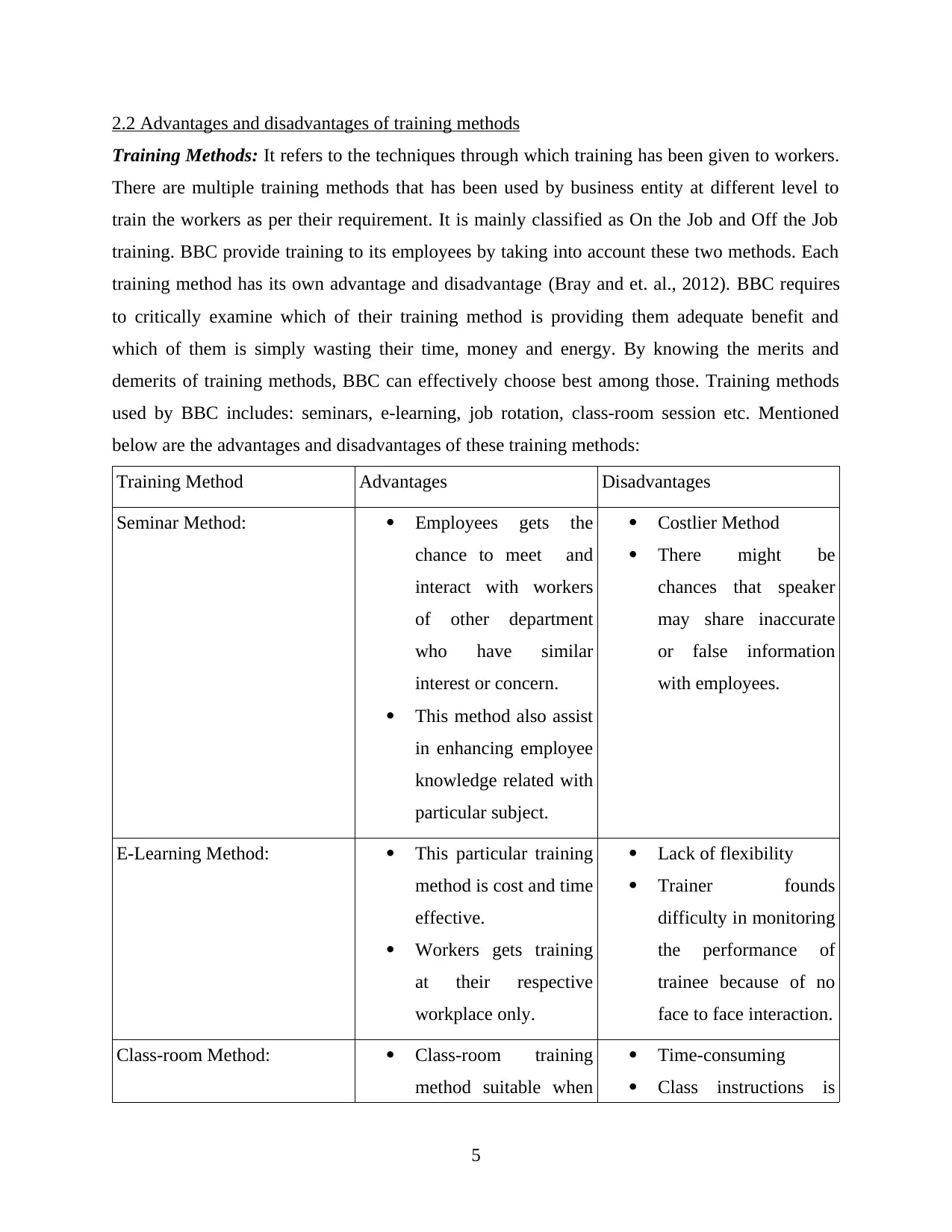
2.2 Advantages and disadvantages of training methods
Training Methods: It refers to the techniques through which training has been given to workers.
There are multiple training methods that has been used by business entity at different level to
train the workers as per their requirement. It is mainly classified as On the Job and Off the Job
training. BBC provide training to its employees by taking into account these two methods. Each
training method has its own advantage and disadvantage (Bray and et. al., 2012). BBC requires
to critically examine which of their training method is providing them adequate benefit and
which of them is simply wasting their time, money and energy. By knowing the merits and
demerits of training methods, BBC can effectively choose best among those. Training methods
used by BBC includes: seminars, e-learning, job rotation, class-room session etc. Mentioned
below are the advantages and disadvantages of these training methods:
Training Method Advantages Disadvantages
Seminar Method: Employees gets the
chance to meet and
interact with workers
of other department
who have similar
interest or concern.
This method also assist
in enhancing employee
knowledge related with
particular subject.
Costlier Method
There might be
chances that speaker
may share inaccurate
or false information
with employees.
E-Learning Method: This particular training
method is cost and time
effective.
Workers gets training
at their respective
workplace only.
Lack of flexibility
Trainer founds
difficulty in monitoring
the performance of
trainee because of no
face to face interaction.
Class-room Method: Class-room training
method suitable when
Time-consuming
Class instructions is
5
Training Methods: It refers to the techniques through which training has been given to workers.
There are multiple training methods that has been used by business entity at different level to
train the workers as per their requirement. It is mainly classified as On the Job and Off the Job
training. BBC provide training to its employees by taking into account these two methods. Each
training method has its own advantage and disadvantage (Bray and et. al., 2012). BBC requires
to critically examine which of their training method is providing them adequate benefit and
which of them is simply wasting their time, money and energy. By knowing the merits and
demerits of training methods, BBC can effectively choose best among those. Training methods
used by BBC includes: seminars, e-learning, job rotation, class-room session etc. Mentioned
below are the advantages and disadvantages of these training methods:
Training Method Advantages Disadvantages
Seminar Method: Employees gets the
chance to meet and
interact with workers
of other department
who have similar
interest or concern.
This method also assist
in enhancing employee
knowledge related with
particular subject.
Costlier Method
There might be
chances that speaker
may share inaccurate
or false information
with employees.
E-Learning Method: This particular training
method is cost and time
effective.
Workers gets training
at their respective
workplace only.
Lack of flexibility
Trainer founds
difficulty in monitoring
the performance of
trainee because of no
face to face interaction.
Class-room Method: Class-room training
method suitable when
Time-consuming
Class instructions is
5
Paraphrase This Document
Need a fresh take? Get an instant paraphrase of this document with our AI Paraphraser
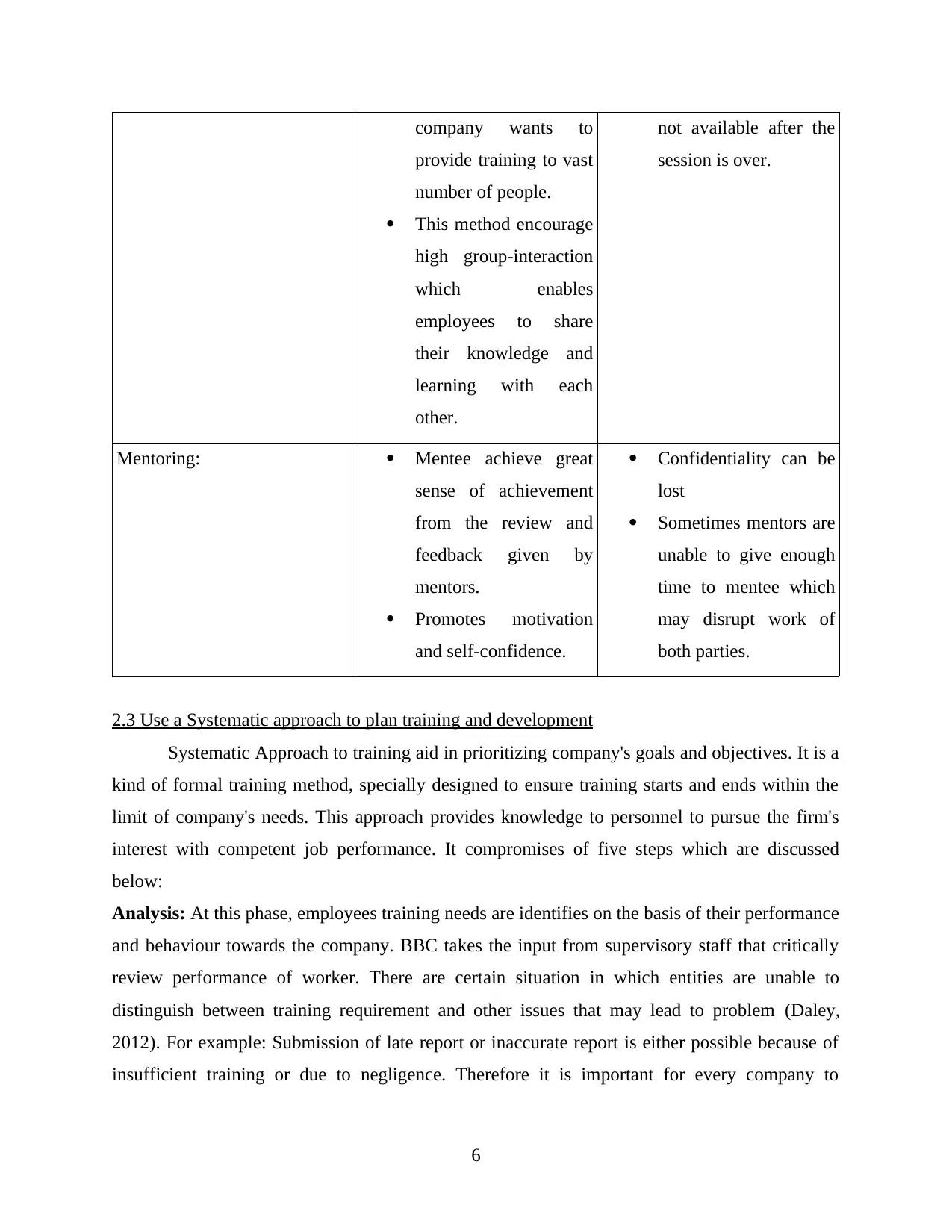
company wants to
provide training to vast
number of people.
This method encourage
high group-interaction
which enables
employees to share
their knowledge and
learning with each
other.
not available after the
session is over.
Mentoring: Mentee achieve great
sense of achievement
from the review and
feedback given by
mentors.
Promotes motivation
and self-confidence.
Confidentiality can be
lost
Sometimes mentors are
unable to give enough
time to mentee which
may disrupt work of
both parties.
2.3 Use a Systematic approach to plan training and development
Systematic Approach to training aid in prioritizing company's goals and objectives. It is a
kind of formal training method, specially designed to ensure training starts and ends within the
limit of company's needs. This approach provides knowledge to personnel to pursue the firm's
interest with competent job performance. It compromises of five steps which are discussed
below:
Analysis: At this phase, employees training needs are identifies on the basis of their performance
and behaviour towards the company. BBC takes the input from supervisory staff that critically
review performance of worker. There are certain situation in which entities are unable to
distinguish between training requirement and other issues that may lead to problem (Daley,
2012). For example: Submission of late report or inaccurate report is either possible because of
insufficient training or due to negligence. Therefore it is important for every company to
6
provide training to vast
number of people.
This method encourage
high group-interaction
which enables
employees to share
their knowledge and
learning with each
other.
not available after the
session is over.
Mentoring: Mentee achieve great
sense of achievement
from the review and
feedback given by
mentors.
Promotes motivation
and self-confidence.
Confidentiality can be
lost
Sometimes mentors are
unable to give enough
time to mentee which
may disrupt work of
both parties.
2.3 Use a Systematic approach to plan training and development
Systematic Approach to training aid in prioritizing company's goals and objectives. It is a
kind of formal training method, specially designed to ensure training starts and ends within the
limit of company's needs. This approach provides knowledge to personnel to pursue the firm's
interest with competent job performance. It compromises of five steps which are discussed
below:
Analysis: At this phase, employees training needs are identifies on the basis of their performance
and behaviour towards the company. BBC takes the input from supervisory staff that critically
review performance of worker. There are certain situation in which entities are unable to
distinguish between training requirement and other issues that may lead to problem (Daley,
2012). For example: Submission of late report or inaccurate report is either possible because of
insufficient training or due to negligence. Therefore it is important for every company to
6
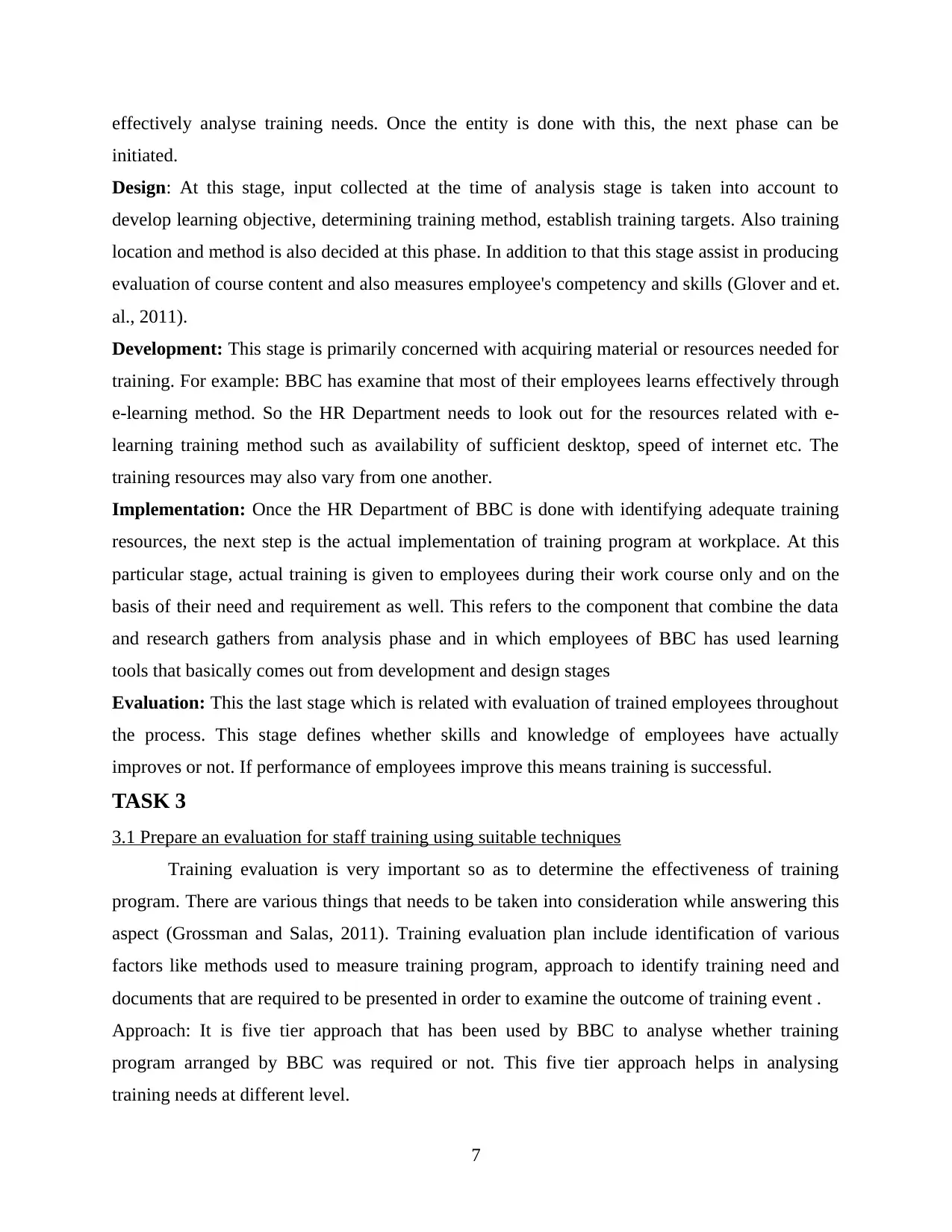
effectively analyse training needs. Once the entity is done with this, the next phase can be
initiated.
Design: At this stage, input collected at the time of analysis stage is taken into account to
develop learning objective, determining training method, establish training targets. Also training
location and method is also decided at this phase. In addition to that this stage assist in producing
evaluation of course content and also measures employee's competency and skills (Glover and et.
al., 2011).
Development: This stage is primarily concerned with acquiring material or resources needed for
training. For example: BBC has examine that most of their employees learns effectively through
e-learning method. So the HR Department needs to look out for the resources related with e-
learning training method such as availability of sufficient desktop, speed of internet etc. The
training resources may also vary from one another.
Implementation: Once the HR Department of BBC is done with identifying adequate training
resources, the next step is the actual implementation of training program at workplace. At this
particular stage, actual training is given to employees during their work course only and on the
basis of their need and requirement as well. This refers to the component that combine the data
and research gathers from analysis phase and in which employees of BBC has used learning
tools that basically comes out from development and design stages
Evaluation: This the last stage which is related with evaluation of trained employees throughout
the process. This stage defines whether skills and knowledge of employees have actually
improves or not. If performance of employees improve this means training is successful.
TASK 3
3.1 Prepare an evaluation for staff training using suitable techniques
Training evaluation is very important so as to determine the effectiveness of training
program. There are various things that needs to be taken into consideration while answering this
aspect (Grossman and Salas, 2011). Training evaluation plan include identification of various
factors like methods used to measure training program, approach to identify training need and
documents that are required to be presented in order to examine the outcome of training event .
Approach: It is five tier approach that has been used by BBC to analyse whether training
program arranged by BBC was required or not. This five tier approach helps in analysing
training needs at different level.
7
initiated.
Design: At this stage, input collected at the time of analysis stage is taken into account to
develop learning objective, determining training method, establish training targets. Also training
location and method is also decided at this phase. In addition to that this stage assist in producing
evaluation of course content and also measures employee's competency and skills (Glover and et.
al., 2011).
Development: This stage is primarily concerned with acquiring material or resources needed for
training. For example: BBC has examine that most of their employees learns effectively through
e-learning method. So the HR Department needs to look out for the resources related with e-
learning training method such as availability of sufficient desktop, speed of internet etc. The
training resources may also vary from one another.
Implementation: Once the HR Department of BBC is done with identifying adequate training
resources, the next step is the actual implementation of training program at workplace. At this
particular stage, actual training is given to employees during their work course only and on the
basis of their need and requirement as well. This refers to the component that combine the data
and research gathers from analysis phase and in which employees of BBC has used learning
tools that basically comes out from development and design stages
Evaluation: This the last stage which is related with evaluation of trained employees throughout
the process. This stage defines whether skills and knowledge of employees have actually
improves or not. If performance of employees improve this means training is successful.
TASK 3
3.1 Prepare an evaluation for staff training using suitable techniques
Training evaluation is very important so as to determine the effectiveness of training
program. There are various things that needs to be taken into consideration while answering this
aspect (Grossman and Salas, 2011). Training evaluation plan include identification of various
factors like methods used to measure training program, approach to identify training need and
documents that are required to be presented in order to examine the outcome of training event .
Approach: It is five tier approach that has been used by BBC to analyse whether training
program arranged by BBC was required or not. This five tier approach helps in analysing
training needs at different level.
7
⊘ This is a preview!⊘
Do you want full access?
Subscribe today to unlock all pages.

Trusted by 1+ million students worldwide
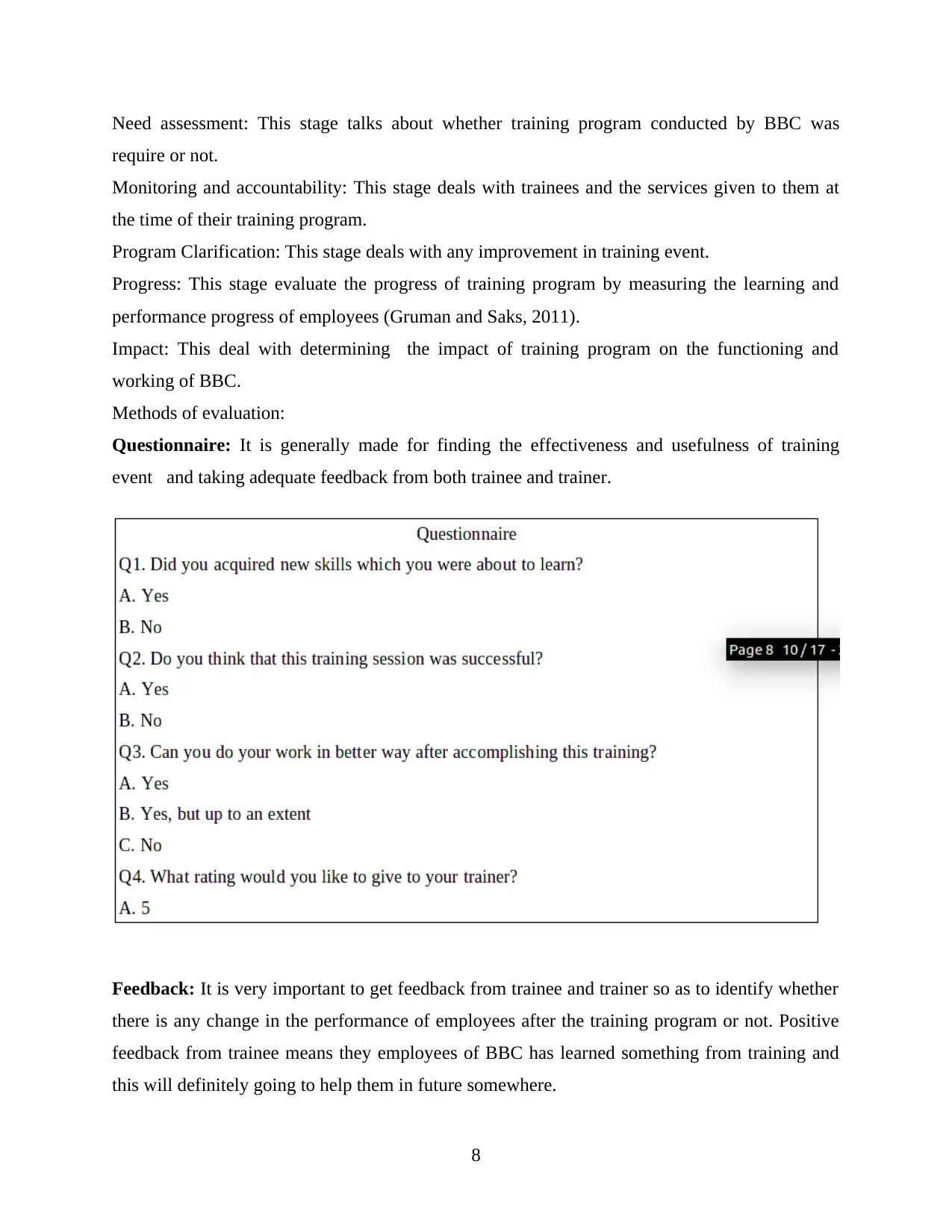
Need assessment: This stage talks about whether training program conducted by BBC was
require or not.
Monitoring and accountability: This stage deals with trainees and the services given to them at
the time of their training program.
Program Clarification: This stage deals with any improvement in training event.
Progress: This stage evaluate the progress of training program by measuring the learning and
performance progress of employees (Gruman and Saks, 2011).
Impact: This deal with determining the impact of training program on the functioning and
working of BBC.
Methods of evaluation:
Questionnaire: It is generally made for finding the effectiveness and usefulness of training
event and taking adequate feedback from both trainee and trainer.
Feedback: It is very important to get feedback from trainee and trainer so as to identify whether
there is any change in the performance of employees after the training program or not. Positive
feedback from trainee means they employees of BBC has learned something from training and
this will definitely going to help them in future somewhere.
8
require or not.
Monitoring and accountability: This stage deals with trainees and the services given to them at
the time of their training program.
Program Clarification: This stage deals with any improvement in training event.
Progress: This stage evaluate the progress of training program by measuring the learning and
performance progress of employees (Gruman and Saks, 2011).
Impact: This deal with determining the impact of training program on the functioning and
working of BBC.
Methods of evaluation:
Questionnaire: It is generally made for finding the effectiveness and usefulness of training
event and taking adequate feedback from both trainee and trainer.
Feedback: It is very important to get feedback from trainee and trainer so as to identify whether
there is any change in the performance of employees after the training program or not. Positive
feedback from trainee means they employees of BBC has learned something from training and
this will definitely going to help them in future somewhere.
8
Paraphrase This Document
Need a fresh take? Get an instant paraphrase of this document with our AI Paraphraser
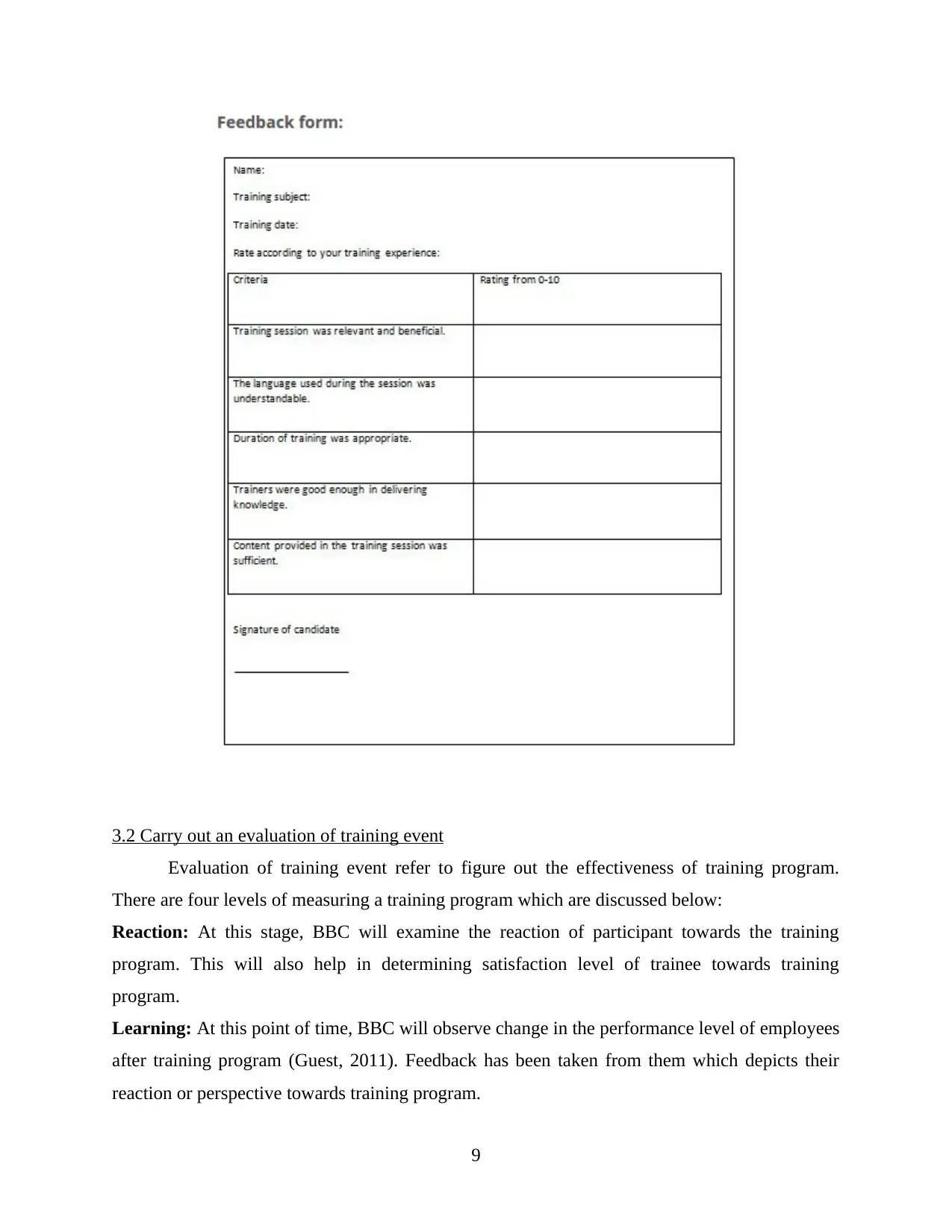
3.2 Carry out an evaluation of training event
Evaluation of training event refer to figure out the effectiveness of training program.
There are four levels of measuring a training program which are discussed below:
Reaction: At this stage, BBC will examine the reaction of participant towards the training
program. This will also help in determining satisfaction level of trainee towards training
program.
Learning: At this point of time, BBC will observe change in the performance level of employees
after training program (Guest, 2011). Feedback has been taken from them which depicts their
reaction or perspective towards training program.
9
Evaluation of training event refer to figure out the effectiveness of training program.
There are four levels of measuring a training program which are discussed below:
Reaction: At this stage, BBC will examine the reaction of participant towards the training
program. This will also help in determining satisfaction level of trainee towards training
program.
Learning: At this point of time, BBC will observe change in the performance level of employees
after training program (Guest, 2011). Feedback has been taken from them which depicts their
reaction or perspective towards training program.
9
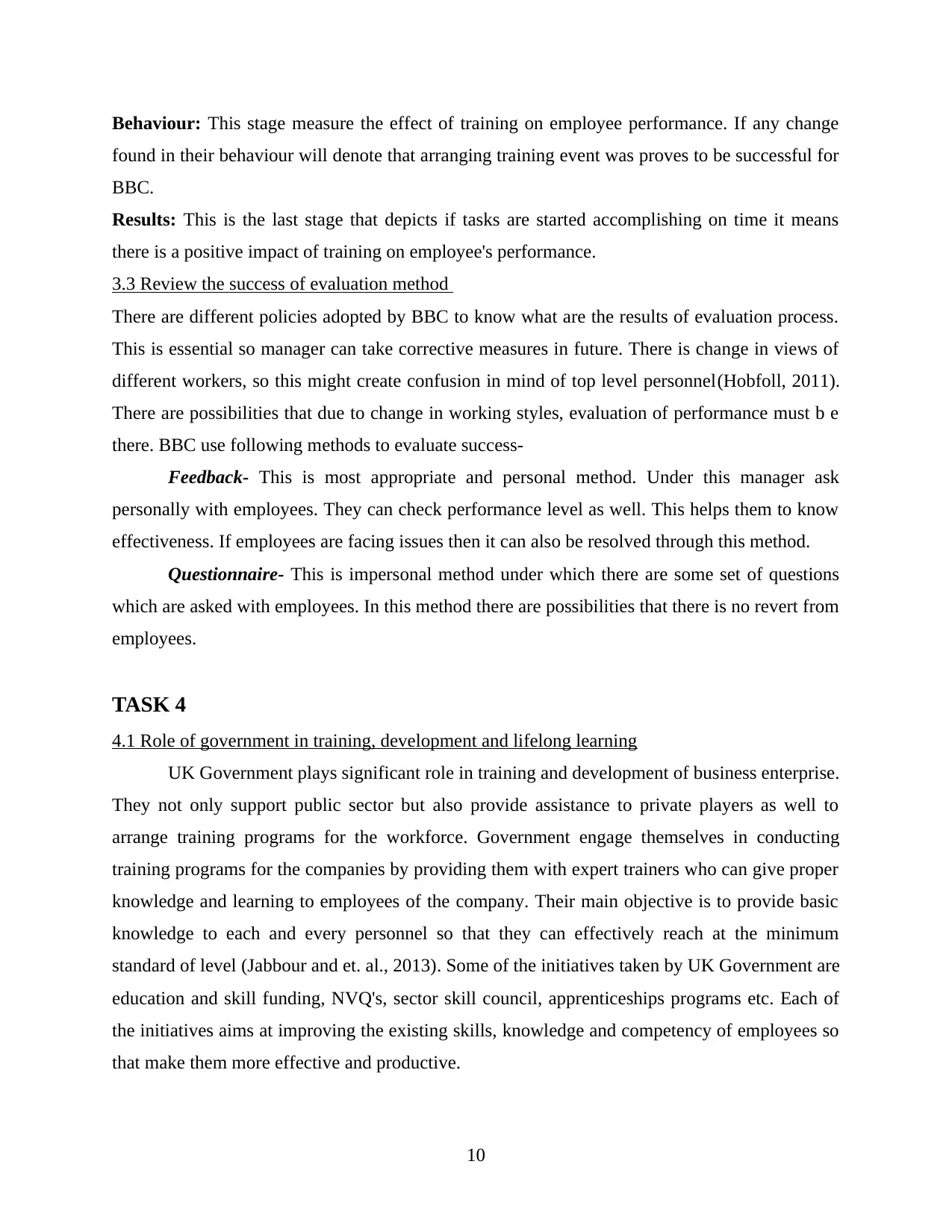
Behaviour: This stage measure the effect of training on employee performance. If any change
found in their behaviour will denote that arranging training event was proves to be successful for
BBC.
Results: This is the last stage that depicts if tasks are started accomplishing on time it means
there is a positive impact of training on employee's performance.
3.3 Review the success of evaluation method
There are different policies adopted by BBC to know what are the results of evaluation process.
This is essential so manager can take corrective measures in future. There is change in views of
different workers, so this might create confusion in mind of top level personnel(Hobfoll, 2011).
There are possibilities that due to change in working styles, evaluation of performance must b e
there. BBC use following methods to evaluate success-
Feedback- This is most appropriate and personal method. Under this manager ask
personally with employees. They can check performance level as well. This helps them to know
effectiveness. If employees are facing issues then it can also be resolved through this method.
Questionnaire- This is impersonal method under which there are some set of questions
which are asked with employees. In this method there are possibilities that there is no revert from
employees.
TASK 4
4.1 Role of government in training, development and lifelong learning
UK Government plays significant role in training and development of business enterprise.
They not only support public sector but also provide assistance to private players as well to
arrange training programs for the workforce. Government engage themselves in conducting
training programs for the companies by providing them with expert trainers who can give proper
knowledge and learning to employees of the company. Their main objective is to provide basic
knowledge to each and every personnel so that they can effectively reach at the minimum
standard of level (Jabbour and et. al., 2013). Some of the initiatives taken by UK Government are
education and skill funding, NVQ's, sector skill council, apprenticeships programs etc. Each of
the initiatives aims at improving the existing skills, knowledge and competency of employees so
that make them more effective and productive.
10
found in their behaviour will denote that arranging training event was proves to be successful for
BBC.
Results: This is the last stage that depicts if tasks are started accomplishing on time it means
there is a positive impact of training on employee's performance.
3.3 Review the success of evaluation method
There are different policies adopted by BBC to know what are the results of evaluation process.
This is essential so manager can take corrective measures in future. There is change in views of
different workers, so this might create confusion in mind of top level personnel(Hobfoll, 2011).
There are possibilities that due to change in working styles, evaluation of performance must b e
there. BBC use following methods to evaluate success-
Feedback- This is most appropriate and personal method. Under this manager ask
personally with employees. They can check performance level as well. This helps them to know
effectiveness. If employees are facing issues then it can also be resolved through this method.
Questionnaire- This is impersonal method under which there are some set of questions
which are asked with employees. In this method there are possibilities that there is no revert from
employees.
TASK 4
4.1 Role of government in training, development and lifelong learning
UK Government plays significant role in training and development of business enterprise.
They not only support public sector but also provide assistance to private players as well to
arrange training programs for the workforce. Government engage themselves in conducting
training programs for the companies by providing them with expert trainers who can give proper
knowledge and learning to employees of the company. Their main objective is to provide basic
knowledge to each and every personnel so that they can effectively reach at the minimum
standard of level (Jabbour and et. al., 2013). Some of the initiatives taken by UK Government are
education and skill funding, NVQ's, sector skill council, apprenticeships programs etc. Each of
the initiatives aims at improving the existing skills, knowledge and competency of employees so
that make them more effective and productive.
10
⊘ This is a preview!⊘
Do you want full access?
Subscribe today to unlock all pages.

Trusted by 1+ million students worldwide
1 out of 18
Related Documents
Your All-in-One AI-Powered Toolkit for Academic Success.
+13062052269
info@desklib.com
Available 24*7 on WhatsApp / Email
![[object Object]](/_next/static/media/star-bottom.7253800d.svg)
Unlock your academic potential
Copyright © 2020–2025 A2Z Services. All Rights Reserved. Developed and managed by ZUCOL.



